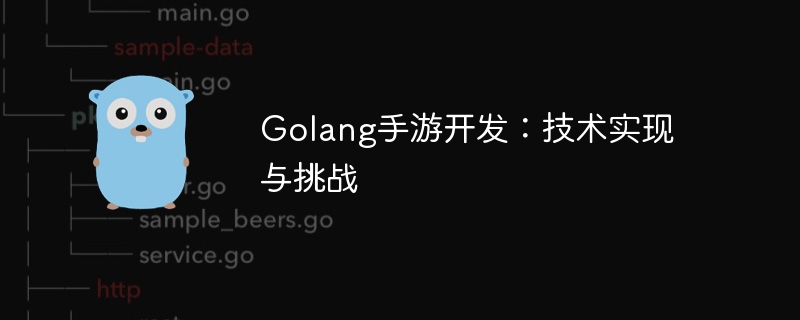

Golang Mobile Game Development: Technical Implementation and Challenges
In recent years, with the popularity of smartphones and the development of mobile Internet, the mobile game market is growing rapidly. More and more developers are paying attention to using Golang language for mobile game development, because Golang is efficient, fast and reliable, and is suitable for processing real-time game logic. This article will explore the technical implementation and challenges of using Golang for mobile game development, and provide some specific code examples.
1. Technical implementation
When using Golang for mobile game development, it is crucial to choose a suitable game engine of. Currently popular game engines include Unity, Unreal Engine and Cocos2d. Although most of these engines are written in C or other languages, they can be integrated through Golang's interface and plug-in mechanism.
Golang inherently supports concurrent programming, which is very advantageous for processing complex real-time logic in mobile games. Using goroutine and channel can easily implement multi-threaded operations and improve the efficiency and performance of the game. The following is a simple concurrent processing code example:
package main
import (
"fmt"
"time"
)
func main() {
ch := make(chan int)
go func() {
for i := 0; i < 5; i++ {
ch <- i
time.Sleep(1 * time.Second)
}
close(ch)
}()
for num := range ch {
fmt.Println(num)
}
}Mobile games usually require a large amount of data interaction with the server, so network communication is essential a part of. Golang provides a rich standard library and supports network programming of TCP, UDP and other protocols. The following is a simple TCP server code example:
package main
import (
"fmt"
"net"
)
func main() {
listen, err := net.Listen("tcp", "localhost:8888")
if err != nil {
fmt.Println("Error listening:", err)
return
}
defer listen.Close()
fmt.Println("Server started, listening on port 8888")
for {
conn, err := listen.Accept()
if err != nil {
fmt.Println("Error accepting connection:", err)
return
}
go handleConnection(conn)
}
}
func handleConnection(conn net.Conn) {
defer conn.Close()
buf := make([]byte, 1024)
_, err := conn.Read(buf)
if err != nil {
fmt.Println("Error reading:", err)
return
}
fmt.Printf("Received data: %s
", string(buf))
}2. Challenges and Solutions
Mobile games have high performance requirements , you need to consider how to optimize the code to improve the running efficiency of the game. You can use Golang's performance analysis tool pprof to locate performance bottlenecks and optimize hotspot codes.
Problems such as memory leaks and memory overflows are prone to occur in mobile game development. You need to pay attention to releasing resources that are no longer used in a timely manner to avoid unnecessary memory. occupied. You can use the garbage collection mechanism provided by Golang to manage memory.
Since mobile games are widely used on mobile devices, security is an important consideration. Developers need to guard against various network attacks and protect users' personal information and game data. Security can be strengthened using Golang’s cryptographic libraries and secure coding practices.
To sum up, using Golang for mobile game development has many advantages, but it also faces some challenges. Only by fully understanding the technical implementation and solving challenges can we develop high-quality, stable and safe mobile game products. I hope that through the introduction of this article, readers can better understand the technical points of Golang mobile game development and achieve success in practice.
The above is the detailed content of Golang mobile game development: technical implementation and challenges. For more information, please follow other related articles on the PHP Chinese website!
 Zero-based Java self-study tutorial
Zero-based Java self-study tutorial
 How to define variables in golang
How to define variables in golang
 What are the data conversion methods in golang?
What are the data conversion methods in golang?
 What are the commonly used libraries in golang?
What are the commonly used libraries in golang?
 What is the difference between golang and python
What is the difference between golang and python
 How to use frequency function
How to use frequency function
 What are the methods to connect to vps server
What are the methods to connect to vps server
 How to connect php to mssql database
How to connect php to mssql database




